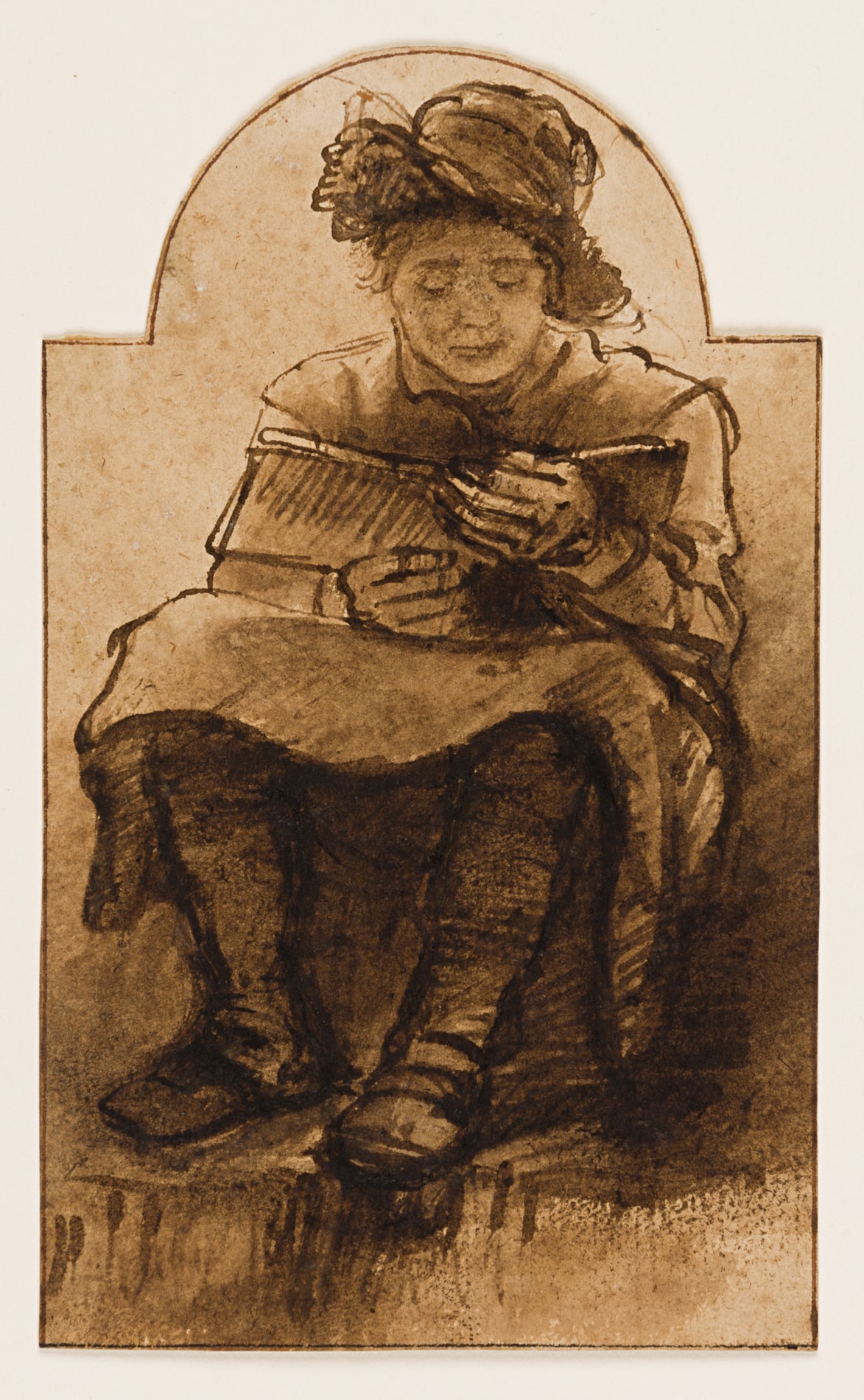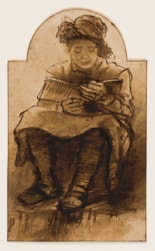Abraham VAN DIJCK
(Dordrecht c.1635 - Dordrecht 1680)
A Seated Youth with a Book
Pen and brush and brown ink and brown wash, with framing lines in brown ink, on paper with a shaped top.
132 x 79 mm. (5 1/4 x 3 1/8 in.) at greatest dimensions.
132 x 79 mm. (5 1/4 x 3 1/8 in.) at greatest dimensions.
The attribution of the present sheet to Abraham Van Dijck is due to Peter Schatborn. Van Dijck’s oeuvre as a draughtsman has yet to be fully studied, and only a few drawings by or attributed to the artist are known today. Werner Sumowski listed only three authentic or signed drawings under the artist’s name, together with a further twenty-eight sheets which he attributed to him, in his magisterial book Drawings of the Rembrandt School, published in 1980. In his recently published monograph on Abraham Van Dijck, David de Witt lists fifty-two drawings by the artist.
One of the few generally accepted drawings by Van Dijck is a study of a seated old woman holding a book, in the Pierpont Morgan Library in New York, which may be regarded as a preliminary study for a painting of an Old Prophetess in the Hermitage in St. Petersburg. As Felice Stampfle and Jane Turner have noted, Sumowski regarded both the Morgan Library drawing and the Hermitage painting ‘to be relatively early works by Abraham Van Dijck, though dating from after c.1650 (the period of his hypothetical apprenticeship with Rembrandt), since, in addition to the influence of Rembrandt, the drawing shows that of Nicolaes Maes…The [Morgan] Library’s drawing provided a cornerstone for Sumowski’s reconstruction of Van Dijck’s drawn oeuvre.’
Schatborn has compared this fine drawing of a young man reading a book in particular with a drawing by Van Dijck of an old man seated in an armchair, datable to c.1665-1660, in the Liberna Collection at the Draiflessen Collection in Mettingen, Germany. As he notes, both drawings share a similar treatment of the outlines of the figure, areas of diagonal pen hatching and tonal washes applied with a dry brush, as well as a distinctive treatment of the hands. As Sumowski has pointed out, the Liberna drawing, which is probably a study for a blind Tobit, is stylistically comparable to both the Morgan Library drawing of a seated old woman and a signed drawing by Van Dijck of the head and shoulders of a young woman, in the collection of the Kunsthalle in Bremen, and the same is true of the present sheet. A somewhat comparable treatment of hands is also found in a drawing of a young man behind a balustrade, attributed by Sumowksi to Van Dijck, which was formerly in the C. R. Rudolf collection in London and was sold at auction in Amsterdam in 1977.
David de Witt has recently related the present sheet in particular to three other stylistically comparable drawings by Van Dijck, each depicting a seated young man wearing a wide-brimmed hat holding a book; a pen and brush study in the Louvre, a similar drawing now in the Tuliba Collection in Mettingen and a slightly larger sheet in the Courtauld Institute Galleries in London. As he writes of these four closely-related drawings, ‘The combined wash and pen technique, and the choppy handling, is sufficiently similar in each [drawing] to surmise that they are by the same artist, trying out variations of the theme in one campaign. The logical succession sees the loose and sketchy Ongpin sheet as first. The Louvre drawing is second, with its indecisive composition and many corrections, in the same hand, refining the pose and costume…The Mettingen drawing frames the figure more decisively, generating an imposing presence…The drawing in the Courtauld then adds a setting, placing the figure beside a large fireplace.’
One of the few generally accepted drawings by Van Dijck is a study of a seated old woman holding a book, in the Pierpont Morgan Library in New York, which may be regarded as a preliminary study for a painting of an Old Prophetess in the Hermitage in St. Petersburg. As Felice Stampfle and Jane Turner have noted, Sumowski regarded both the Morgan Library drawing and the Hermitage painting ‘to be relatively early works by Abraham Van Dijck, though dating from after c.1650 (the period of his hypothetical apprenticeship with Rembrandt), since, in addition to the influence of Rembrandt, the drawing shows that of Nicolaes Maes…The [Morgan] Library’s drawing provided a cornerstone for Sumowski’s reconstruction of Van Dijck’s drawn oeuvre.’
Schatborn has compared this fine drawing of a young man reading a book in particular with a drawing by Van Dijck of an old man seated in an armchair, datable to c.1665-1660, in the Liberna Collection at the Draiflessen Collection in Mettingen, Germany. As he notes, both drawings share a similar treatment of the outlines of the figure, areas of diagonal pen hatching and tonal washes applied with a dry brush, as well as a distinctive treatment of the hands. As Sumowski has pointed out, the Liberna drawing, which is probably a study for a blind Tobit, is stylistically comparable to both the Morgan Library drawing of a seated old woman and a signed drawing by Van Dijck of the head and shoulders of a young woman, in the collection of the Kunsthalle in Bremen, and the same is true of the present sheet. A somewhat comparable treatment of hands is also found in a drawing of a young man behind a balustrade, attributed by Sumowksi to Van Dijck, which was formerly in the C. R. Rudolf collection in London and was sold at auction in Amsterdam in 1977.
David de Witt has recently related the present sheet in particular to three other stylistically comparable drawings by Van Dijck, each depicting a seated young man wearing a wide-brimmed hat holding a book; a pen and brush study in the Louvre, a similar drawing now in the Tuliba Collection in Mettingen and a slightly larger sheet in the Courtauld Institute Galleries in London. As he writes of these four closely-related drawings, ‘The combined wash and pen technique, and the choppy handling, is sufficiently similar in each [drawing] to surmise that they are by the same artist, trying out variations of the theme in one campaign. The logical succession sees the loose and sketchy Ongpin sheet as first. The Louvre drawing is second, with its indecisive composition and many corrections, in the same hand, refining the pose and costume…The Mettingen drawing frames the figure more decisively, generating an imposing presence…The drawing in the Courtauld then adds a setting, placing the figure beside a large fireplace.’
Not much is known of the life and career of the Amsterdam artist Abraham Van Dijck (or Dyck), who remains one of the more obscure artists in the circle of Rembrandt. Relatively few signed or dated paintings and drawings by the artist have survived, and as such a chronology of his career is difficult to establish. The son of a prosperous wine merchant in Dordrecht, he may have studied there initially with Samuel van Hoogstraten, and is thought to have been a pupil in Rembrandt’s Amsterdam studio in the early 1650s. (Van Hoogstraten sent several of his pupils to complete their training with his former master Rembrandt in Amsterdam.) While Van Dijck’s putative period of apprenticeship in Rembrandt’s studio remains undocumented, it is certainly true that his earliest dated painting, a Presentation in the Temple of c.1651, reveals his knowledge of Rembrandt’s style. His work also displays the influence of a number of Rembrandt’s students and followers, in particular Nicolaes Maes, as well as the genre painters Gabriel Metsu, Caspar Netscher and Quentin van Brekelenkam.
Following his time in Amsterdam, Van Dijck returned to his native Dordrecht, where he painted numerous depictions of old women and men - in contemplation, prayer, reading or asleep – that are indebted to the example of Nicolaes Maes. The fact that Maes’s paintings were a particular influence on Van Dijck suggests that the two artists were close, and indeed this may also be said of their families. Van Dijck’s parents lived on the same street as Maes in Dordrecht, and his younger brother Hugo owned a pair of portraits of himself and his late wife; the former by his brother Abraham and the latter by Maes. Around 1660 Van Dijck seems to have moved to Amsterdam. Only three dated works are known from the 1660s, however, and none after 1667. The 18th century biographer Arnold Houbraken claims that Van Dijck worked in England, like his more famous Flemish namesake Anthony Van Dyck, but this remains unproven. The artist, described as ‘Abram van Dijck, bachelor painter’, was buried on 27 August 1680 in the Grote Kerk in Dordrecht.
Only about sixty paintings by Abraham Van Dijck are known today, including just a handful of signed works; in the Royal Collection at Buckingham Palace, the Mauritshuis in The Hague (on long-term loan to the Rembrandt House Museum in Amsterdam), the Isabel and Alfred Bader collection in Milwaukee (promised to the Agnes Etherington Art Centre at Queens University in Kingston, Ontario) the Fürstlich Hohenzollernsche Sammlung at Schloss Sigmaringen and the Hermitage in St. Petersburg, as well as a number of private collections.
Provenance
Jacques Bacri, Paris
Thence by descent.
Thence by descent.
Literature
David de Witt, Abraham Van Dijck c.1635-1680: Life and Work of a Late Rembrandt Pupil, Zwolle, 2020, p.264, no.D34A (where dated c.1657).




